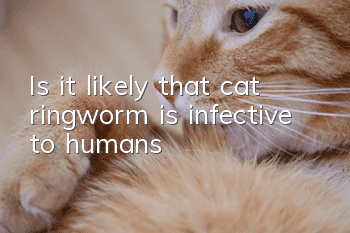Is it likely that cat ringworm is infective to humans?

Cat sucking is a popular Internet term at the moment. It refers to the affectionate actions made by pet owners towards cats. They hold the cat in their arms, put their nose on the cat's body and sniff it vigorously. Related research also shows that sucking cats can help relieve stress and pain.
Maintaining close contact with cats is a kind of happiness for pet owners, but everyone knows that such contact has hidden health risks, including the transmission of skin diseases!
Many pet owners believe that cats’ skin diseases are not contagious to humans. Pipi Mao is here to refute the rumors, of course not! The number one skin disease - cat ringworm is more contagious than you think!
A colleague of the editor suffered from cat ringworm because he did not wash his hands in time after petting the cat. Even after being cured with medication, the condition recurred. Therefore, cat ringworm is very contagious, and pet owners must not take it lightly!
Today, let’s talk to you about cat skin diseases. Which types of skin diseases are contagious to humans? What skin diseases do cats have? How to treat and prevent cat ringworm? What do pet owners need to pay attention to when raising cats? Cleanliness?
Which cat skin diseases are contagious
The causes of cat skin diseases mainly include three aspects: parasites, bacteria, and fungi.
Parasitic skin diseases are contagious to humans. When parasites inhabit human hair or skin tissue, they will cause itching and rash;
Bacteria invade cats’ bodies and cause skin diseases such as eczema and pyoderma. This type of bacteria generally cannot stay in the human body for a long time and is almost non-infectious;
Almost 80% of cat skin diseases are caused by fungi, and cat ringworm is the most common fungal skin disease. Cat ringworm is contagious to humans, and the probability of infection is not low!
Types of cat skin diseases
There are three main causes of cat skin diseases, but the manifestations are diverse. Cat skin diseases include: cat ringworm, eczema, pyoderma, folliculitis, parasitic skin diseases, feline acne, ear mites, feline demodicosis, chelicerate dermatitis, etc.
1. Cat ringworm
Cat ringworm often occurs in malnourished and sickly cats. In addition, cats are also prone to cat ringworm if they live in a humid and high-temperature environment. The symptoms of cat ringworm are skin peeling and hair loss, which spread from a small spot to a round rash the size of a copper coin.
2. Eczema
Humid environment, soaked in sweat, mosquito bites, prolonged heat exposure, unclean skin, contact with chemical agents, etc. can all cause eczema. Eczema can be distributed all over the cat's body, with varying degrees of erythema, papules, blisters, pustules, and desquamation, eventually causing the cat to lose hair in large areas.Mi may be losing weight day by day.
3. Pyoderma
Pyoderma is a skin disease caused by bacterial infection, which manifests as local suppuration and inflammation of the skin, accompanied by papules, ulcers, scabs, etc. It can also cause eczema and folliculitis.
4. Folliculitis
Folliculitis is a type of skin disease mainly caused by excessive hormone secretion in cats (too greasy food can also cause folliculitis), also known as black chin! The symptoms are black granular objects on the cat’s tail and chin , rubbing with your hands will cause hair to fall off.
5. Parasitic skin diseases
Parasites such as fleas, ticks, and mites hide in the cat's skin. They bite the blood and secrete toxins, causing itching of the cat's skin. Cats may aggravate the infection by scratching and biting, with symptoms including papules, redness, swelling, and hair loss.
6. Chelicarial mite dermatitis
This skin disease is also a parasitic skin disease. The cheliceae parasite lives on the skin surface and causes non-suppurative dermatitis in cats. After infection, dry dandruff will appear on the cat, causing itching and hair loss. This skin disease mostly occurs in kittens, but humans can also be infected.
7. Cat acne
Cats’ lack of cleaning habits, weak constitution, stress response, immune mechanism and other factors are all factors that cause cat acne. Feline acne may be just a small pustule in the early stage. In the later stage, if it is severe, it will appear as a swollen black pustule, accompanied by alopecia, dander, papules and erythema.
8. Ear mites
Ear scabies parasitizes in the cat’s ears and causes ear mite skin disease. The symptoms are reddish-brown, brown or black secretions in the cat’s ear canal, and may develop to the head and neck in severe cases. Cats with ear mites will shake their heads and scratch their ears with their claws.
9. Feline demodicosis
This is an immunodeficiency skin disease, and purebred cats are generally more likely to be infected. Symptoms include well-defined red spots on the cat's eyes, lips, inner legs, and hairless areas of the ears, which can cause hair loss, edema, and other phenomena.
Treatment of cat ringworm
Although cat ringworm is not a serious skin disease, it is common and easy to recur. More importantly, it is highly contagious to humans, so we will mainly talk about the treatment and prevention of cat ringworm. Cat ringworm is divided into mild cat ringworm, moderate cat ringworm and severe cat ringworm according to different stages of onset.
1. Treatment of mild cat ringworm
Cat ringworm does not require excessive treatment if it is not severe. As long as you give your cat more sun and better nutrition, it will get better on its own. In addition, you must blow dry your cat in time after bathing to ensure the dryness of the skin.
2. Treatment of moderate cat ringworm
If the cat has skin peeling and hair loss, it means that the cat ringworm has turned into moderate cat ringworm. At this time, medication must be taken in time.To prevent aggravation.
The treatment method is to first shave off the hair on the cat's ringworm area, then wipe off the dandruff, and gently wipe off the hard scab, then wipe the affected area with the medicine and massage it gently until it is absorbed. In addition to skin medication, it is also combined with medicated baths. Medicinal bath can be performed every 2 weeks for 10-15 minutes each time.
3. Treatment of severe cat ringworm
If the commonly used medicines and medicated baths cannot cure cat ringworm, and the cat’s hair loss area no longer grows new hair, it means that the cat ringworm has worsened. At this time, in addition to applying medicine and medicated bath, oral medicine and injection medicine should also be used. However, because oral medications and injections can cause certain damage to cats’ organs, their use is not recommended except as a last resort.
In the process of treating cat ringworm, it is crucial to get more sun and supplement nutrition. Cats suffering from cat ringworm can be fed some vitamin B to help the skin recover.
Prevention of cat ringworm
To prevent cat ringworm, we should start from three aspects: eating a healthy diet, paying attention to cleanliness and hygiene, and regular deworming.
1. Eat healthily
If you want your cat’s skin to have high resistance, nutritional supplements are crucial. In addition to daily cat food, owners can supplement it with vitamins, minerals, unsaturated acids and other substances that are beneficial to skin nutrition.
2. Pay attention to cleanliness and hygiene
We should not only pay attention to the cleanliness of the cat itself, but also ensure that the cat’s living environment is clean. Owners should ensure that the home is regularly ventilated, and cat enclosures, cat basins, cat litters and other cat supplies should be cleaned and disinfected frequently, and exposed to the sun as much as possible.
It is also necessary to deworm and bathe cats regularly. But don’t bathe too frequently. Long-haired cats can take a bath every 2-3 months, and short-haired cats can take a bath once every 4 months or even half a year. Do not use human body wash for bathing, but a specialized pet body wash. You should also blow dry and thoroughly after bathing!
3. Regular deworming
After 4 weeks, you can take the kitten to the hospital for the first deworming. Generally, internal deworming is done before or after meals. Let the cat fast for 2-3 hours, and then feed internal deworming medicine for 1 hour. Do not eat inside. Also, do not deworm when you are sick. Do not take a shower, catch a cold, or eat randomly after deworming.
If cats suffer from tinea felis, owners must treat them promptly. You should also wash your hands promptly after touching your cat. If you are unfortunately infected, you can exercise more, get more sunshine and take vitamin B2. If you are still unable to recover, seek medical treatment in time.
Okay, the editor has finished talking to you today about the popular science content about cat skin diseases. Cat skin diseases are not serious diseases, but they require timely and accurate medication. Pippi Cat hereby wishes that all cats can be healthy and accompany every pet owner!
- How did Siamese cats develop the habit of sleeping at night? The truth is...
- Change cats’ bad habit of scratching and damaging furniture
- Is there any harm in shaving your cat in summer?
- Is it okay for cats to only eat rice?
- What supplements can cats take when eating chicken liver?
- Can kittens be vaccinated after 45 days?
- Does a cat still recognize its owner after being beaten?
- Does the British Shorthair lose hair?
- How to treat vomiting in British shorthair cats, teach you step by step
- Can cats with herpes virus infect pregnant women?



